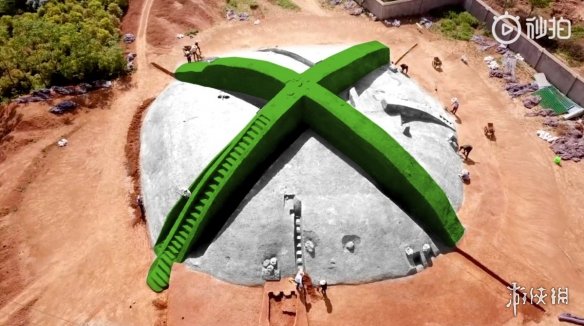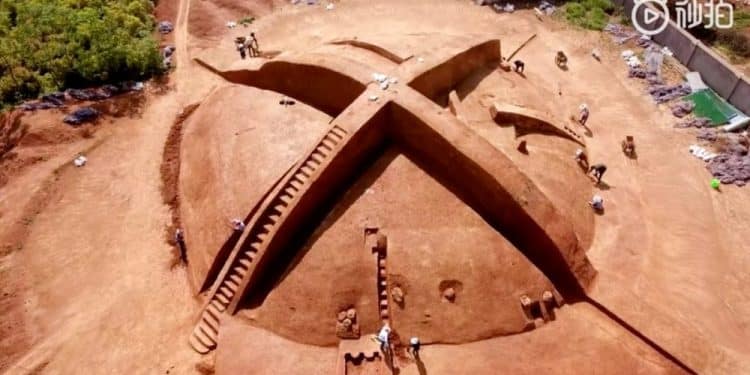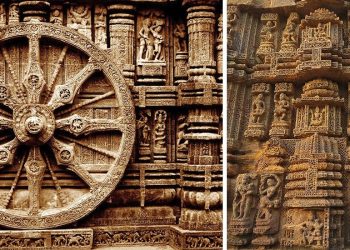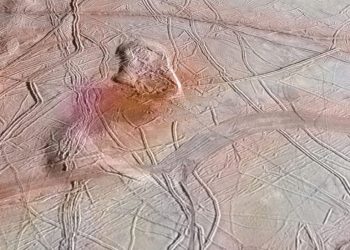X-shaped Qin Dynasty tomb discoveries are rare — and this one might be the strangest yet. Hidden beneath a remote field in China’s Shaanxi Province, archaeologists have uncovered a perfectly symmetrical “X”-shaped burial site dating back more than 2,200 years. Its design is unlike anything seen from the first imperial dynasty of China, and its unusual structure may hold clues to long-lost burial traditions from a time when power and the afterlife were inseparable.
Tombs from the Qin Dynasty are rare, but when they are found, they typically follow well-established forms — rectangular chambers, axial symmetry, and directional alignment with celestial or cultural significance.
But this tomb is different. Its intersecting corridors create an unmistakable “X,” dividing the burial space into sharply defined quadrants. This isn’t an accident of erosion or collapsed architecture — the design appears intentional, methodical, and symbolically charged.
Researchers believe this pattern may represent an unrecorded funerary style, possibly reserved for individuals of unique political or spiritual status during the Qin era. It’s not yet clear who was buried here, but the tomb’s layout alone raises new questions about what we thought we knew.

The Qin Dynasty’s obsession with order
To understand the significance of this discovery, it helps to understand the world the tomb came from. The Qin Dynasty (221–206 BCE) marked the beginning of China’s imperial history, founded by Qin Shi Huang, the first emperor to unify the warring states.
The Qin regime was defined by rigid legalism, centralized control, and an obsession with uniformity. Weights, measures, currency, and even written language were standardized across the empire. The dynasty also reshaped landscapes — connecting walls into the earliest Great Wall, building massive road systems, and commissioning colossal infrastructure projects.
Burial practices were no exception. Death was treated as a continuation of political order. Elaborate tombs like the Terracotta Army, buried to protect Qin Shi Huang in the afterlife, reflected a belief that status and hierarchy persisted beyond death.
What X-shaped Qin Dynasty tomb: A possible elite burial — or something else?
The precise “X” design of this tomb doesn’t match any known Qin burial typology — making it either a highly specialized elite grave or a symbolic structure with astronomical or cosmological significance.
Some researchers speculate it may align with ancient beliefs in the cardinal directions, yin-yang duality, or the five-phase (wuxing) theory — philosophies central to Chinese cosmology at the time. Others wonder if it could be part of a larger, hidden burial complex waiting to be unearthed.
At the very least, it suggests a burial tradition not previously documented in historical records.
From viral meme to historical mystery
When aerial photos of the excavation surfaced on social media, people were quick to joke about its resemblance to the Xbox logo. Even Microsoft’s Xbox account chimed in, calling it the “Xbox 220 BC.” But beneath the meme-worthy shape lies a serious and valuable archaeological find.
Footage released by China’s CCTV10 network confirms the tomb’s authenticity. The site is now under active study, and researchers hope future excavations will uncover burial goods, inscriptions, or human remains that can shed light on the tomb’s true purpose.
The Qin Dynasty lasted just 15 years, but its cultural footprint reshaped China for two millennia. Every new discovery from this period offers a rare chance to peer into the foundations of imperial China — a world where power, belief, and mortality were deeply intertwined.
The X-shaped Qin Dynasty tomb may be one of those discoveries. Not because of how strange it looks, but because of what it might reveal about a culture that ruled through absolute order… and buried its dead in symbols we are only beginning to decode.











